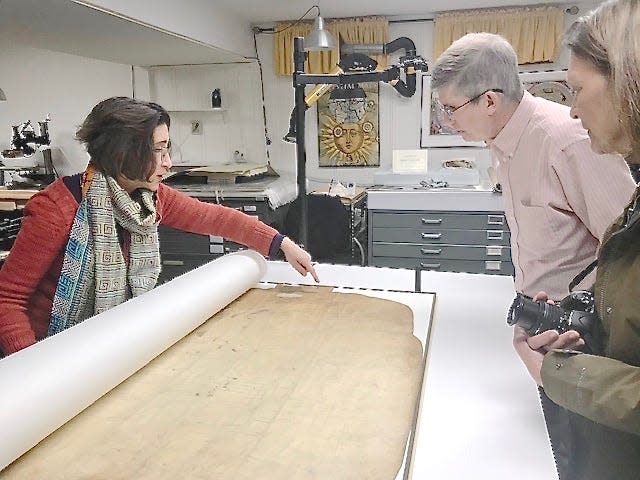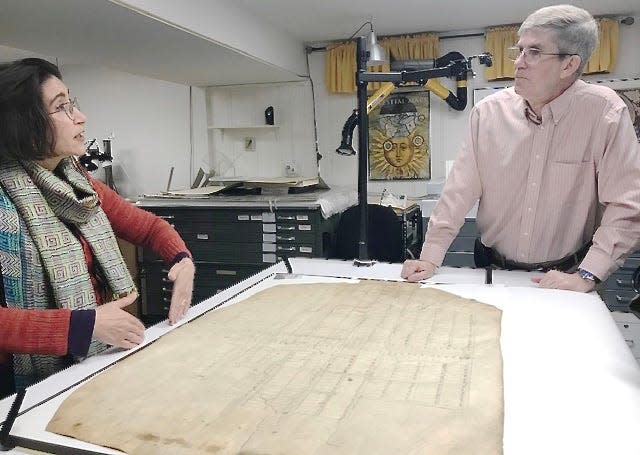A growing town, a Rebel invasion: Saving the documents that tell county's story
- Oops!Something went wrong.Please try again later.
- Oops!Something went wrong.Please try again later.
Most of us would likely assume that Hagerstown grew outward from an original group of lots around the Square that were first plotted by Jonathan Hager when he founded the town in the 1760s.
But thanks to the preservation of an early 19th-century plat, Hagerstonians can soon see for themselves how the town began to blossom in the years after the American Revolution.
After nearly two years in the hands of an expert document conservator, the plat and other documents — including a rare copy of Gen. Robert E. Lee's proclamation to Marylanders in the days preceding the Battle of Antietam — are finally home with the Washington County Historical Society.
Plans are to keep the delicate originals stored and preserved, but display copies for everyone to see.

A town on the move
"My best guess is the plat plan was generated in the early 1800s," said society President Bill Maharay. "It descended through the Hager family; it's on vellum, and it shows the development of Hagerstown through various growth patterns.
"The original layout of the town was basically the first east and west blocks of Washington Street, Potomac Street and Franklin, that was it," he said.
This plat shows where the town was expanding as it developed.
"And it's not done in an orderly fashion," Maharay said. "What I find most interesting is the water source for the town was the stream that starts up over by where the post office is. It's now all underground, but it shows that stream pattern. And then the area on North Potomac where it rises up past Franklin was called the 'healthy' part of town because of sanitation."
Various notations on the plat show where early churches and businesses were, and one details the coming railroad.
But the plat clearly predates Hagerstown's "Hub City" status.
Society officials aren't sure how it became part of its collection, but knew this piece of Hagerstown history had to be preserved.
And there were some other documents that needed to be restored and preserved as well — including correspondence with former Gov. William Paca, who also was a signer of the Declaration of Independence, and one of a handful of known copies of the document Lee used to ingratiate Confederate troops with Marylanders during his northern campaign in 1862.
It came from what Maharay calls the "Seibert collection," saved over the years by the Seibert family of Clear Spring.
When a family member who had inherited the collection asked if the society were interested in the materials, "needless to say, I said, 'Absolutely!'" Maharay recalled. "And among the items that the family had saved was the Lee proclamation.
"As best as I can determine, the Museum of the Confederacy (in Richmond) has a copy; the Maryland Historical Society has a copy," Maharay said.

Cash or fire: Locals had a stark choice in 1864. Was this trunk used to collect the money?
A ghostly tale: Who's haunting the home of Hagerstown's founder?
'Multi-sensory experience': 25-room 'boutique hotel' planned for Hagerstown
He believes there probably is at least one more.
A former curator at the society recommended Janice Ellis, who had worked with her husband at the Smithsonian, to do the preservation work.
"Janice came and saw all the items and explained the very intense process that she does, and we were so impressed with her," said historical society Executive Director Robyn Sumner.
But conserving the documents has been an expensive — and lengthy — proposition, Maharay and Sumner said. Sumner said the society had a $10,000 contract with Ellis for the work, but hadn't seen the final bill.
They plan to cover much of the cost with grant money, but the society also is accepting donations.
Saving history
Ellis has had a long career in conserving historical books and documents, including for the New York Public Library, and a lengthy association with the Smithsonian after she completed graduate work at Columbia University. She works independently now from a lab in her Silver Spring, Md., home.
It's filled with work tables, computers, some pretty serious high-tech magnifiers and a huge antique paper trimmer that she uses to cut materials for protective coverings. Shelves along the walls are filled with materials to preserve various kinds of papers without harming them.
It's meticulous work. She's had the Hagerstown plat, for example, for nearly two years.
When Maharay and Sumner arrived last week to pick up the documents, Ellis explained how to handle and store them — and why. It can be a bit technical, but the bottom line is clean hands, a gentle touch and protective folders.
Different adhesives are used for repairs and preservation, depending on the type of paper and ink of the document.
Along with the documents, Ellis returned a little packet of debris she had removed from the surface of the plat.
"Everything that you take off has potential for DNA analysis," she said. "It's a new technology that they're just starting to use now."
So all that … stuff … could tell who in Hagerstown's early history had handled the plat?
"All of this surface dirt that just looks like dirt not only is really valuable to people who are doing research on animal husbandry (the vellum is likely made from sheepskin), … but also, it's gotten so sophisticated now that they can pick up the DNA of the users," Ellis said.
So, yes.
'You don't want to dress your grandmother to look like Lady Gaga'
Ellis told The Herald-Mail she'd always had a love of art, and interests in craft and sciences. Her career has allowed her to combine all of that while salvaging valuable historical items.
"You have to know a little about the history of the object, obviously, a little about the material science — what made it fail in the first place? And you want your repairs to be sympathetic with the original, but you don't want it to set it up for a second failure," she said.
"So you don't do it the same way the original craftsman did it, because that failed … it's a lot of problem-solving, but with the eye of an artist and the hand of an artist, and hopefully the mind of a historian and scientist."
And when she's working on one of these documents, does she ever want to just go research the story behind it?
"YES! Oh yes, oh yes. Yeah. I mean, that's part of the joy of it," Ellis said. "And sometimes we find things that the curators didn't even know, which is really lovely."
A project that particularly affected her, she said, was a request from a woman who brought her documents so tightly folded the owner couldn't tell open them to find out what they were.
As Ellis worked with the documents, she discovered they were the manumission papers — documents granting legal freedom — for the owner's enslaved ancestor.
"When you see how much information they can find in this beaten-up original thing, it makes you think three and four times about what you change (in order to preserve them). And sometimes, clients want it to look new. And it's like, you don't want it to look new, you know, you don't want to dress your grandmother to look like Lady Gaga. You want your grandmother to look like your grandmother."
Lee's proclamation
One of the items conserved for the Washington County Historical Society is a rare copy of Gen. Robert E. Lee's proclamation to the residents of Maryland at the beginning of the Maryland Campaign in September 1862, which culminated in the Battle of Antietam. Here's what Lee told them:
It is right that you should know the purpose that brought the Army under my command within the limits of your State, so far as that purpose concerns yourselves.
The People of the Confederate States have long watched with the deepest sympathy the wrongs and outrages that have been inflicted upon the citizens of a Commonwealth, allied to the States of the South by the strongest social, political and commercial ties.
They have seen with profound indignation their sister State deprived of every right, and reduced to the condition of a conquered Province.
Under the pretense of supporting the Constitution, but in violation of its most valuable provisions, your citizens have been arrested and imprisoned upon no charge, and contrary to all forms of law; the faithful and manly protest against this outrage made by the venerable and illustrious Marylanders to whom in better days, no citizens appealed for right vain, was treated with scorn and contempt; the government of your chief city has been usurped by armed strangers; your legislature has been dissolved by the unlawful arrest of its members; freedom of the press and of speech, of the Federal Executive, and citizens ordered to be tried by a military commission for what they may dare to speak.
Believing that the People of Maryland possessed a spirit too lofty to submit to such a government, the people of the south have long wished to aid you in throwing off this foreign yoke, to enable you to again enjoy the inalienable rights of free men, and restore independence and sovereignty to your State.
In obedience to this wish, our Army has come among you, and is prepared to assist you with the power of its arms in regaining the rights of which you have been despoiled.
This, Citizens of Maryland, is our mission, so far as you are concerned.
No constraint upon your free will is intended, no intimidation is allowed.
Within the limits of this Army, at least, Marylanders shall once more enjoy their ancient freedom of thought and speech.
We know no enemies among you, and will protect all of every opinion.
It is for you to decide your destiny, freely and without constraint.
This army will respect your choice whatever it may be, and while the Southern people will rejoice to welcome you to your natural position among them, they will only welcome you when you come of your own free will.
R. E. Lee, General Commanding.
This article originally appeared on The Herald-Mail: Historical Society preserves 18th-, 19th-century documents

